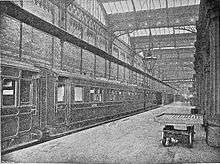Fleetwood railway station
There have been three locations for Fleetwood railway station in Fleetwood, Lancashire, England. The first, from 1840 to 1883, was in Dock Street, opposite Church Street. The second, from 1883 to 1966, was in Queen's Terrace. From 1966 to 1970, the station previously known as Wyre Dock railway station was renamed "Fleetwood".
| Fleetwood | |
|---|---|
.jpg) Trams in front of the second Fleetwood station on Queen's Terrace in 1959 | |
| Location | |
| Place | Fleetwood |
| Area | Wyre |
| Coordinates | 53.9256°N 3.0055°W |
| Grid reference | SD 3407 4819 |
| Operations | |
| Original company | Preston and Wyre Joint Railway |
| Pre-grouping | Preston and Wyre Joint Railway |
| Post-grouping | London, Midland and Scottish Railway |
| Platforms | 5 |
| History | |
| 16 July 1840 | First station opened |
| 15 July 1883 | First station closed; second station opened |
| 18 April 1966 | Second station closed |
| Disused railway stations in the United Kingdom | |
| Closed railway stations in Britain A B C D–F G H–J K–L M–O P–R S T–V W–Z | |
In 2009, the Association of Train Operating Companies proposed a new station at Fleetwood as part of a plan to expand the national rail network.[1]
Dock Street
| Maps showing 1st Fleetwood Station |
| OS 1:10000 Map on MARIO (1848) |
| Other maps |
The Preston and Wyre Joint Railway from Preston to Fleetwood was originally opened on 15 July 1840,[2] with a terminus in Dock Street, opposite Church Street.[3] (In the original plan for the new town, the station was to be at the end of London Street, directly from the Mount, but the plan was not followed.)[4] The single-track line ran over an embankment and a timber trestle bridge in straight line northwards across the marshy Wyre estuary, with the station at the far end of the bridge. Within six years the trestle became unsafe and the railway was re-routed slightly inland, and the track doubled. Beyond the passenger station was a goods station at the south end of Queen’s Terrace.[3]
Between 1841 and 1848, Fleetwood was a part of the "West Coast Main Line" equivalent of its time. The fastest route from London to Glasgow was by train to Fleetwood, and thence by packet boat to Ardrossan. After 1848, the entire journey could be made by rail.[2][5][6]
Queen’s Terrace


| Maps showing 2nd Fleetwood Station |
| NPE Maps (1947) |
| Vision of Britain |
| OS 1:2500 Map on MARIO (1892) |
| Other maps |
In July 1883,[7] a replacement station was built opposite the north end of Queen's Terrace, which served as Fleetwood's main railway terminus from then until 18 April 1966, when it was closed due to the Beeching Cuts.[6][8]
The railway approached the station from the south. Platforms 1 and 4 ran the full length of the station, the northern half of each platform being under a glass-roofed train shed. Between the platforms were the booking office, waiting rooms, left luggage office and so on. Platforms 2 and 3 were shorter bay platforms which did not enter the train shed. Platform 5 was the boat train platform, the longest of all, which ran outside the train shed along its eastern side. At the north end was a glass-roofed concourse, running from the Queen's Terrace entrance to the jetty for steamers on the side of the Wyre.[9] On the north side of the concourse were refreshment rooms, separately for first- and second-class passengers. There were further goods sheds and sidings to east of the station.[10]
The station was demolished after closure and a restaurant built on part of the site. In 1973, the remainder was developed into a container port facility, operating ro-ro service to Northern Ireland, which continued until January 2011, when Stena Line removed the Fleetwood to Larne route.
Wyre Dock
When the Queen’s Terrace station closed, passenger service was relocated to the existing Wyre Dock railway station, which was situated at the southern end of Dock Street, about a half-mile away, and which was then renamed "Fleetwood" station.[6]
Notes
- "BBC NEWS - England - Operators call for new rail lines". BBC News. 15 June 2009. Retrieved 15 June 2009.
- Suggitt, p.36
- Mitchell & Hartley, Fig.4
- Mitchell & Hartley, p.17
- Greville & Holt 1960, p. 96.
- Welch, p.28
- Suggitt, p.37
- Suggitt, p.39
- Holme 2016, p. 106.
- Taylor, pp.132–149
References
- Greville, M.D.; Holt, G.O. (February 1960). "Railway Development in Preston—1" (PDF). Railway Magazine. Vol. 106 no. 706. pp. 94–101, 125. Archived from the original (PDF) on 29 August 2017.CS1 maint: ref=harv (link)
- Holme, Geoff (August 2016). Peascod, Michael (ed.). "An Edwardian Tour by the Furness Railway". Cumbrian Railways. Pinner: Cumbrian Railways Association. 12 (3). ISSN 1466-6812.CS1 maint: ref=harv (link)
- Mitchell, L. and Hartley, S. (2005) "Lancashire Historic Town Survey—Fleetoood" (PDF). (9.95 MiB), Lancashire County Council and Egerton Lea Consultancy, accessed 25 October 2007.
- Suggitt, G. (2003, revised 2004) Lost Railways of Lancashire, Countryside Books, Newbury, ISBN 1-85306-801-2
- Taylor, S. (2005) Kirkham to Blackpool (North) and Fleetwood for the Isle of Man, Foxline, Bredbury, ISBN 1-87011-974-6
- Welch, M.S. (2004) Lancashire Steam Finale, Runpast Publishing, Cheltenham, ISBN 1-870754-61-1
External links
- Poulton and Wyre Railway Society, working towards restoring passenger services to Fleetwood.
| Preceding station | Disused railways | Following station | ||
|---|---|---|---|---|
| Terminus | Preston and Wyre Joint Railway Fleetwood Branch Line |
Wyre Dock |